Triumvirate technique used for sinking nucleus with deficient sulcus support
A modified posterior assisted levitation technique can be used with IOL scaffold and glued IOL.

A posterior capsular tear during phacoemulsification can be surgically challenging, and the surgical difficulty is inversely proportional to the timing of the tear during the phaco procedure. When a tear occurs in the early phases of nuclear sculpting and fragmentation, it can be more difficult for the surgeon as compared with this mishap happening toward the end of the procedure. Regardless of when the tear occurs, the primary surgical objectives are prevention of posterior vitreous cavity migration of the nuclear remnants, management of anterior vitreous, prevention of iatrogenic iris tissue damage, and retention of the anatomic integrity of the zonular-capsular complex.
The posterior capsule with intact zonular circumferential support of the capsular bag acts as a partially protective divisional screen between the anterior and posterior chambers. An opening in the posterior capsule somewhat unifies the two chambers into one, with the opening serving as the communicating channel through which the nuclear fragments can often gravitate toward the posterior pole and retina. To artificially re-establish the protective screen, various methods have been used intraoperatively after anterior transfer of the sinking nucleus into the anterior chamber, such as the Sheets glide, the IOL scaffold technique and other devices. After removal of the lens material, a three-piece IOL can often be placed in the ciliary sulcus. However, when the posterior capsular compromise is coupled with inadequate or deficient ciliary sulcus tissue support for the IOL, then alternative techniques need to be utilized in which the IOL is suspended from the sclera.
In this column, Drs. Narang and Agarwal describe their triple, or triumvirate, technique in a sinking cataract nucleus with deficient sulcus support.
Thomas “TJ” John, MD
OSN Surgical Maneuvers Editor


Drs. Kelman and Packard described posterior assisted levitation (PAL) as a technique to levitate a sinking nucleus into the anterior chamber from a pars plana incision with the help of a rod. Viscoat-assisted PAL was later described by Chang and colleagues wherein a Viscoat-filled syringe attached to a cannula is used to levitate the nuclei in the anterior chamber. IOL scaffold has been previously described as a technique that facilitates nuclear emulsification in cases of posterior capsule rupture wherein a three-piece IOL is preplaced in the anterior chamber beneath the nuclear fragments and is made to rest either on the anterior surface of the iris or in the sulcus. Glued IOL is an established technique for secondary IOL placement. In a routine glued IOL surgery, two sclerotomies are made beneath the scleral flaps at a distance of 1 mm from the limbus. In triumvirate, these sclerotomy sites are employed for performing PAL, and this is addressed as modified PAL. Triumvirate comprises three techniques that are essentially performed in combination with each other for successful levitation of a sinking nucleus in absence of sulcus support, ie, modified PAL with IOL scaffold and glued IOL procedure.
Surgical technique
This technique was performed in cases with insufficient sulcus support and nuclei sinking in the anterior vitreous. After a posterior capsule rupture, the phaco procedure was halted and an ophthalmic viscosurgical device was injected to prevent further extension of the posterior capsule rupture. Two partial-thickness scleral flaps were made 180° opposite to each other followed by sclerotomy with a 22-gauge needle at a distance of 1 mm from the limbus beneath the flaps. A rod or a spatula was inserted from these sclerotomy sites and positioned beneath the nuclear fragments, which were then levitated into the anterior chamber.
A three-piece foldable IOL was then injected into the anterior chamber, and the optic of the IOL was positioned beneath the nuclear fragments so that it could act as a scaffold and prevent the nuclear pieces from falling down into the vitreous cavity. The phaco probe was introduced into the anterior chamber, and the nuclear pieces were emulsified at low parameters. A vitrectomy probe was introduced from the sclerotomy site, and the retropupillary area was vitrectomized, clearing off the vitreous strands.
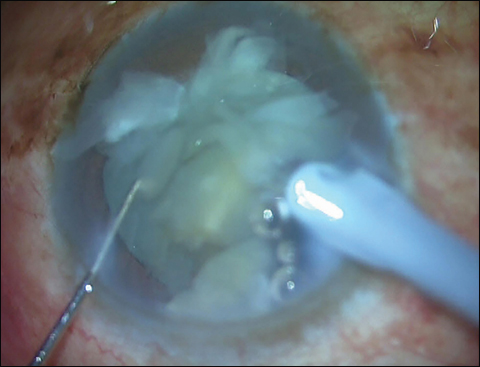
Images: Narang P, Agarwal A

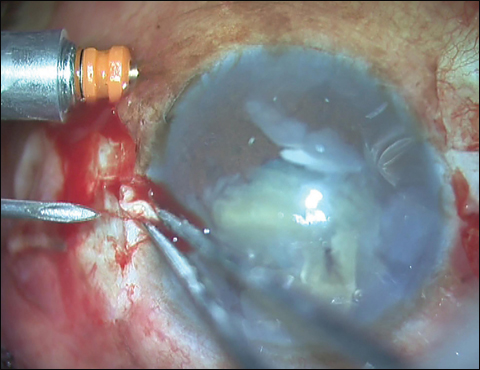
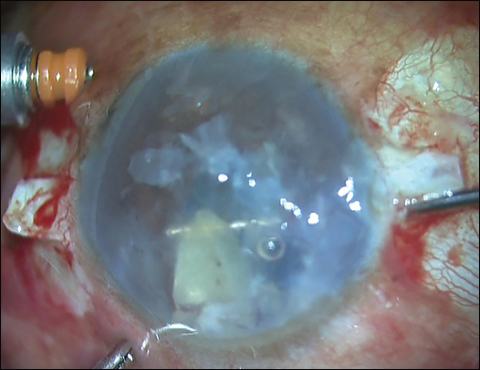

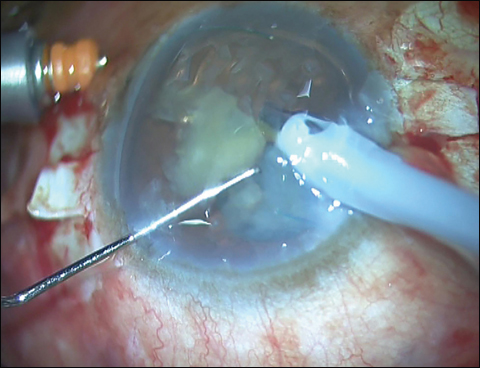
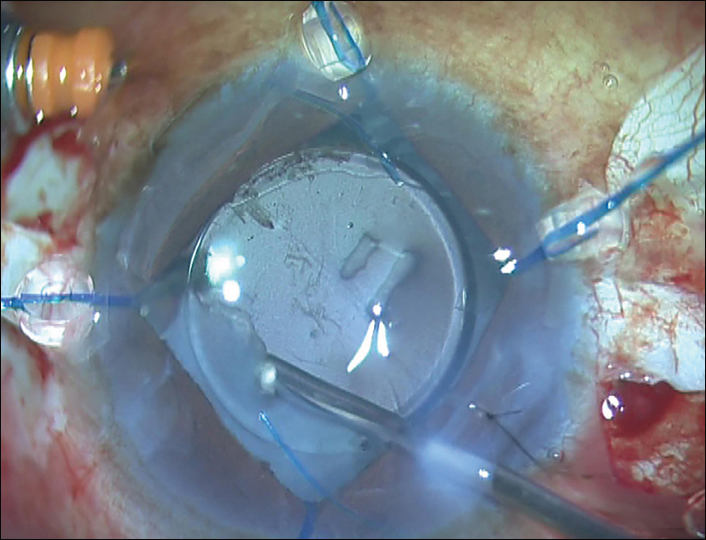


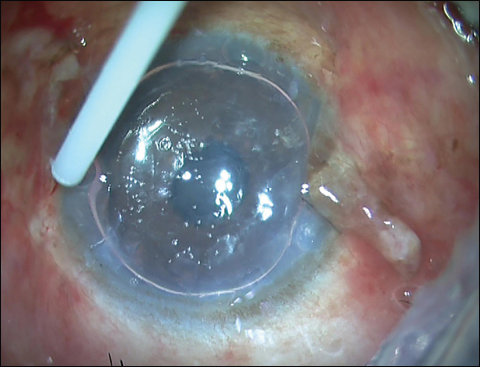
The haptics were externalized from the respective sclerotomy sites by manipulating the haptic from the anterior chamber to behind the iris tissue and then by grasping the tip and pulling and externalizing it with the help of glued IOL forceps. Once the haptics were externalized, they were tucked into the scleral pockets followed by removal of fluid infusion and application of fibrin glue beneath the scleral flaps and on all the conjunctival wounds.
Discussion
A sinking nucleus can be encountered intraoperatively in cataract surgery after a posterior capsule rupture and is a cause of concern. The fragments lying in the anterior vitreous can be levitated into the anterior chamber whereas the fragments in the mid-vitreous cavity should be carefully gauged before an attempt is made to retrieve them. The anterior segment surgeon should not approach fragments beyond the mid-vitreous cavity, and the case should be referred to a vitreoretinal surgeon.
Performing a PAL from the existing sclerotomy site obviates the need to create a separate pars plana incision, and because the PAL is performed from the existing sclerotomy site at 1 mm from the limbus instead of the routine 3 mm, this procedure is called a modified PAL. Because the sulcus support is deficient, the haptics of the IOL are placed on the anterior surface of the iris, and phacoemulsification of the fragments is performed as in an IOL scaffold procedure. The haptics of the same IOL are maneuvered behind the iris surface and externalized as in a glued IOL procedure. The limitation of this technique is that the surgeon should be well acquainted and proficient with all the techniques and should be able to perform them in complete sync with each other.
The advantage with the procedure is that the preplaced three-piece IOL that acts as a scaffold can be fixated into a glued IOL procedure, ensuring a closed chamber procedure and all its inherent advantages.
- References:
- Kumar DA, et al. J Refract Surg. 2012;doi:10.3928/1081597X-20120413-01.
- McKee Y, et al. J Cataract Refract Surg. 2014;doi:10.1016/j.jcrs.2014.04.027.
- Narang P, et al. J Cataract Refract Surg. 2015;doi:10.1016/j.jcrs.2015.10.035.
- Piccone MR, et al. J Cataract Refract Surg. 1997;doi:10.1016/S0886-3350(97)80140-X.
- Schutz JS, et al. Curr Opin Ophthalmol. 2010;doi:10.1097/ICU.0b013e328333101d.
- Sheets JH, et al. Arch Ophthalmol. 1978;doi:10.1001/archopht.1978.03910050095024.
- For more information:
- Amar Agarwal, MS, FRCS, FRCOphth, can be reached at Dr. Agarwal’s Eye Hospital, 19 Cathedral Road, Chennai 600086, India; email: dragarwal@vsnl.com.
- Priya Narang, MS, can be reached at Narang Eye Care & Laser Centre, Ahmedabad, India; email: narangpriya19@gmail.com.
- Edited by Thomas “TJ” John, MD, a clinical associate professor at Loyola University at Chicago and in private practice in Oak Brook, Tinley Park and Oak Lawn, Ill. He can be reached at email: tjcornea@gmail.com.
Disclosures: Agarwal, Narang and John report no relevant financial disclosures.
